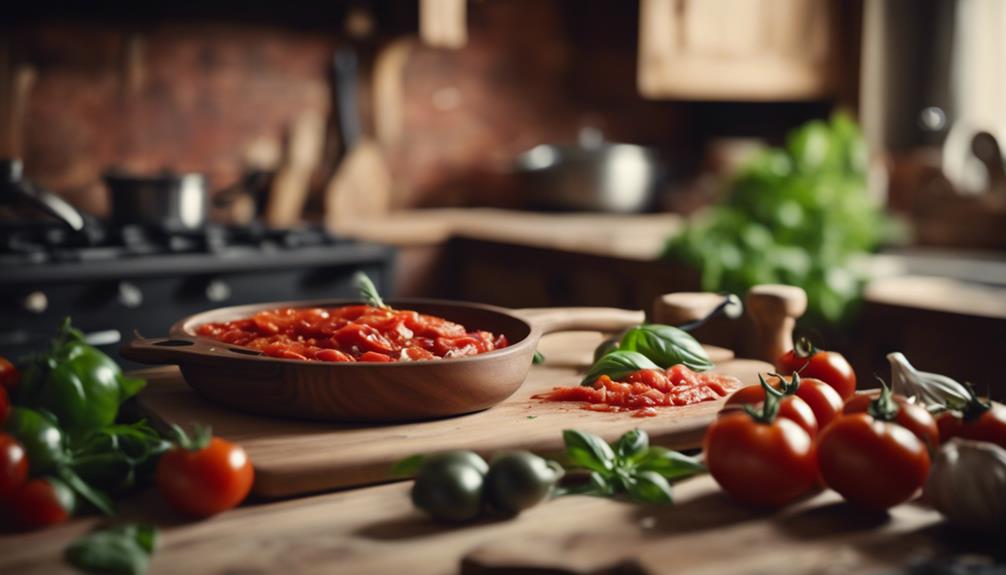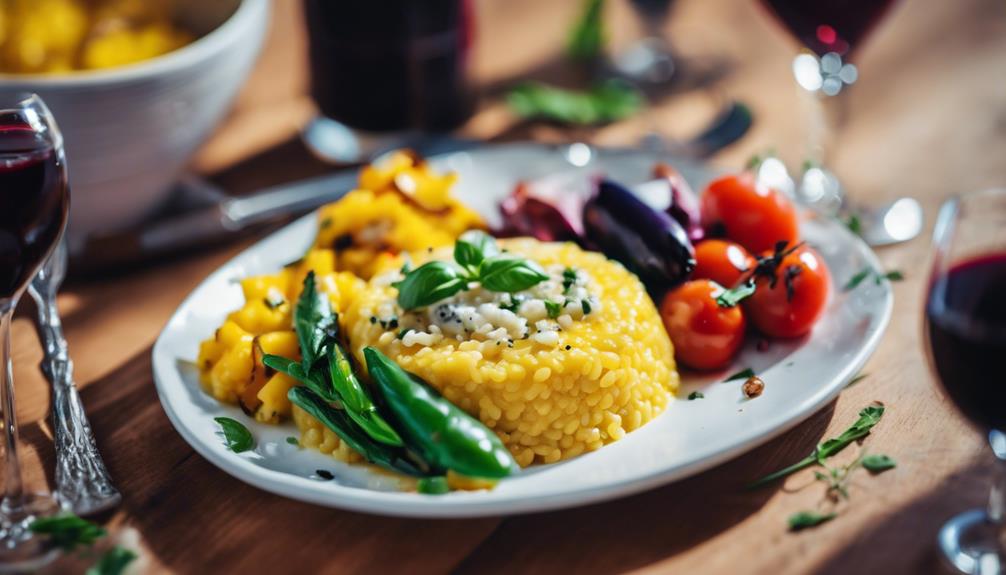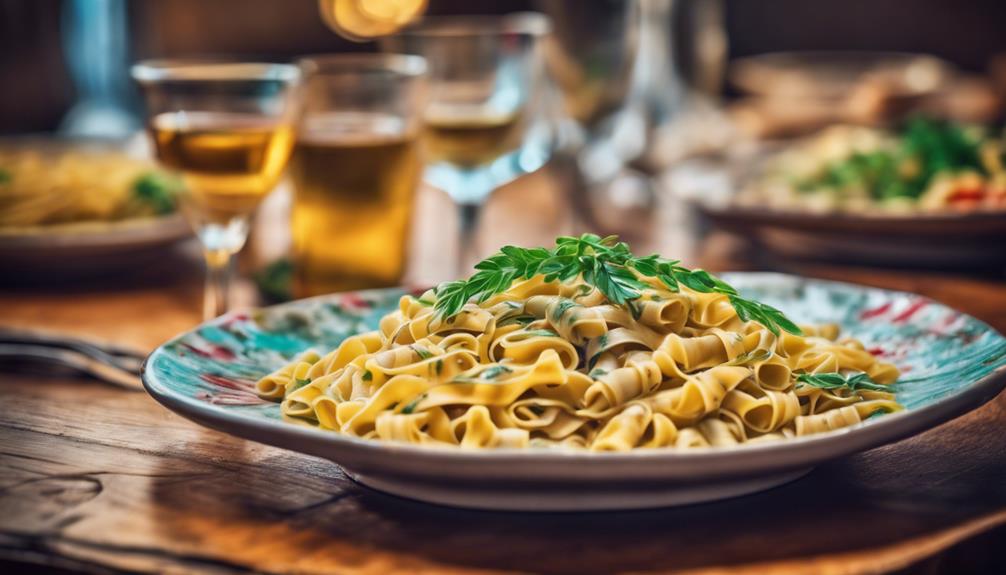Italian cuisine incorporates rosemary in various dishes such as roasted lamb, Tuscan-style chicken, and focaccia bread. The herb’s distinct flavor enhances traditional meat stews, grilled meats, and roast chicken dishes to a whole new level of tastiness. Whether you prefer meat or are a vegetarian, rosemary brings a touch of elegance and Mediterranean charm to your beloved Italian dishes. Don’t overlook the versatility of this herb in pasta sauces, grilled vegetables, and even roasted potatoes. Embrace the aroma and flavor of rosemary in Italian cuisine for an authentic and delightful culinary experience.
Key Takeaways
- Rosemary is commonly used in Italian meat dishes like roasted lamb, grilled meats, and stews.
- It enhances the flavor profile of traditional Italian roasts and meat stews.
- Rosemary pairs well with ingredients like butternut squash, potatoes, and olives in vegetarian Italian dishes.
- The herb adds aromatic goodness to dishes like rosemary roasted vegetables and butternut squash risotto.
- Traditional Italian favorites like roast chicken with rosemary showcase the herb's versatility and Mediterranean charm.
Rosemary in Roasted Lamb
Adding rosemary to roasted lamb enhances its flavor profile, creating a delightful Mediterranean twist on this classic Italian dish. The aromatic and piney notes of rosemary perfectly complement the rich and tender meat of the lamb, creating a harmonious blend of flavors that's sure to please your taste buds.
When preparing roasted lamb with rosemary, infusing olive oil with this herb, along with garlic and salt, is a common practice in Italian cuisine. This infusion adds an extra layer of depth to the dish, elevating it to a whole new level of deliciousness.
Roasted lamb with rosemary is a popular choice for festive occasions and special gatherings in Italy. The earthy undertones of rosemary combined with the succulent meat of the lamb make this dish a standout favorite among both locals and visitors.
Tuscan-Style Chicken With Rosemary

Enhance your culinary skills with the rustic flavors of Tuscan-style chicken infused with aromatic rosemary, a classic dish in Italian cuisine. When preparing this mouthwatering dish, consider the following tips to make your Tuscan-style chicken with rosemary a standout meal:
- Use Chicken Thighs: Opt for chicken thighs instead of breasts for a juicier and more flavorful result, as the thighs hold up well to the robust flavors of rosemary and garlic.
- Fresh Rosemary: Fresh rosemary is key to infusing the dish with its fragrant and earthy aroma. Chop the rosemary finely to release its oils and maximize its flavor.
- Garlic and Olive Oil: Sauté minced garlic in olive oil until fragrant before adding the chicken thighs, creating a flavorful base for the dish.
- Optional White Wine: For an extra layer of flavor, deglaze the pan with a splash of white wine before simmering the chicken thighs to tender perfection.
With these simple yet essential steps, you'll be on your way to savoring a taste of Tuscany in the comfort of your own kitchen.
Rosemary in Focaccia Bread
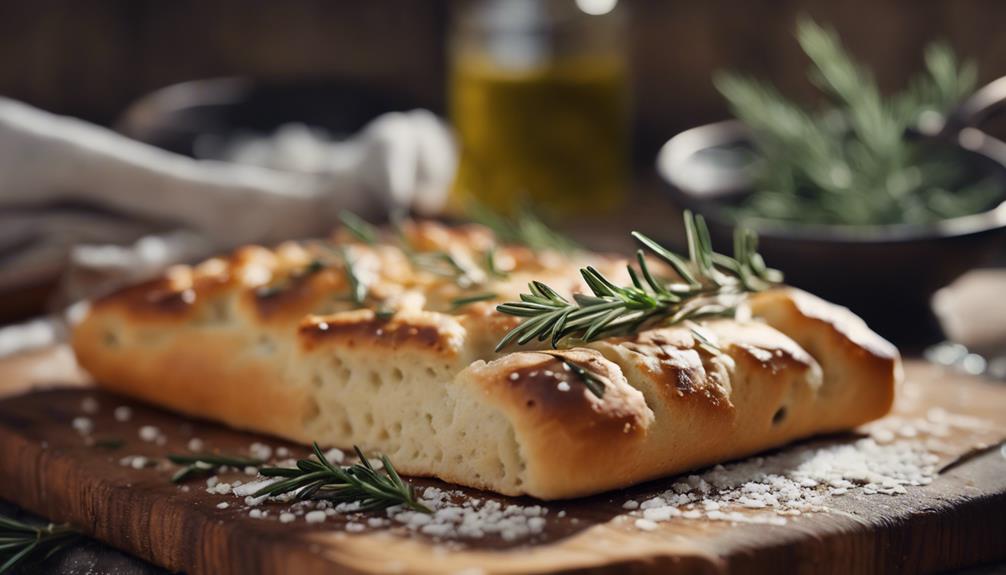
Consider incorporating rosemary into your focaccia bread for a delightful infusion of fragrant and savory flavors. Focaccia bread, a traditional Italian dish, is elevated by the addition of rosemary, adding an aromatic element that beautifully complements the richness of olive oil in the bread. The combination of rosemary and salt flakes sprinkled on top of focaccia creates a unique taste profile that's beloved in Italian cuisine.
Adding rosemary to your focaccia isn't only delicious but also easy. This herb enhances the overall taste of the bread, providing depth and complexity that make it a versatile and flavorful option for any meal.
The aroma of freshly baked focaccia with rosemary wafting through your kitchen is sure to make mouths water.
Pasta Sauces With Rosemary
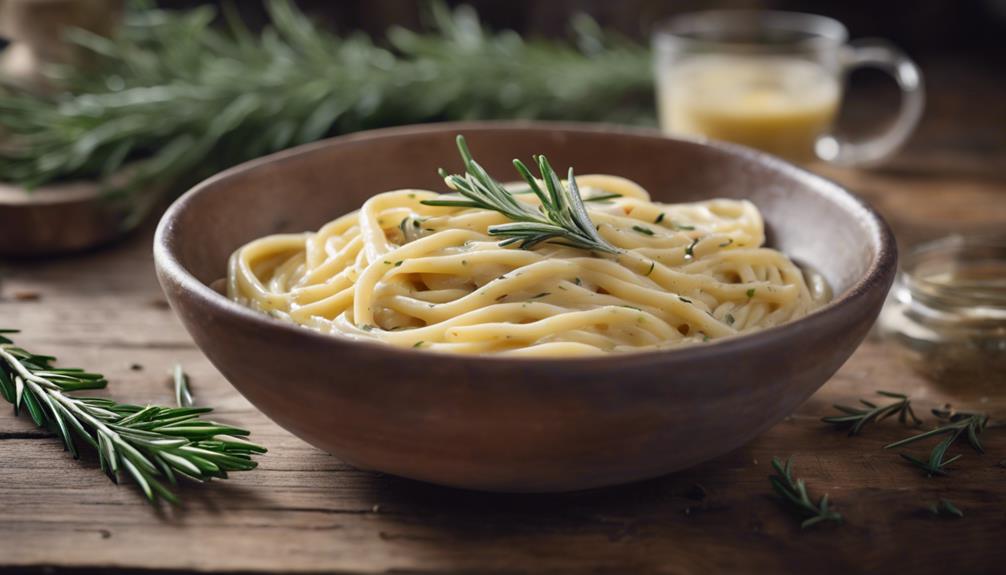
Imagine this – a classic marinara sauce infused with the earthy notes of rosemary, adding depth and flavor complexity to your spaghetti.
Or how about a vibrant pesto sauce with a hint of rosemary, bringing a fresh and herbaceous twist to your favorite pasta dishes?
Time to level up your pasta game with these delightful rosemary-infused sauces!
Rosemary in Marinara
Infuse your marinara sauces with rosemary to elevate the flavors of your pasta dishes with a fragrant and earthy twist. Here's why rosemary in marinara is a game-changer:
- Enhanced Flavors: Rosemary adds depth to marinara, creating a savory and aromatic profile that tantalizes your taste buds.
- Perfect Pairing: Rosemary-infused marinara sauces are a classic match for pasta dishes like spaghetti or penne, enhancing the overall taste experience.
- Unique Aroma: The pine-like scent of rosemary complements the tomatoes and garlic in the marinara, offering a unique twist on traditional flavors.
- Versatile Herb: Italian dishes featuring pasta with rosemary-infused marinara showcase the herb's versatility in elevating the taste profile of a simple dish.
Pesto With Rosemary
Enhance your pasta dishes with the aromatic and flavorful twist of rosemary-infused pesto. Pesto with rosemary offers a delightful variation on the traditional Italian sauce by combining the freshness of basil with the earthy notes of rosemary. The addition of rosemary not only infuses the pesto with a unique aromatic element but also adds a depth of flavor that elevates your dish to new heights.
This versatile condiment can be used as a pasta sauce, a spread for sandwiches, or a flavorful topping for grilled meats and vegetables. The herbaceous and slightly piney taste of rosemary pairs perfectly with the nuttiness of pine nuts and the sharpness of Parmesan cheese in the pesto, creating a harmonious blend of flavors.
Next time you're looking to add a vibrant and herbaceous profile to your meal, consider incorporating pesto with rosemary for a deliciously satisfying twist that will leave your taste buds wanting more.
Grilled Vegetables and Rosemary
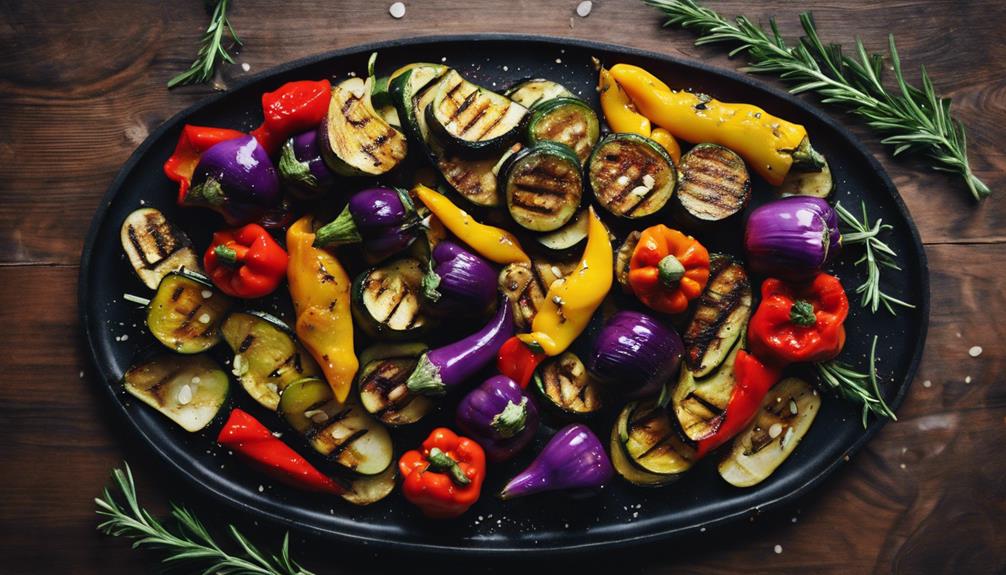
Grilling vegetables with rosemary elevates their flavors and creates a delightful aroma that enhances the overall dish. Here's why you should try this delicious Italian classic:
- Simplicity meets freshness: The combination of grilled vegetables and rosemary is a simple yet flavorful dish that captures the essence of Italian cuisine.
- Aromatic enhancement: Rosemary's fragrant and earthy notes infuse the vegetables with a delightful taste that's both comforting and satisfying.
- Versatile vegetable options: From zucchini to bell peppers, eggplant, and cherry tomatoes, there's a wide variety of vegetables you can grill with rosemary to create a colorful and nutritious meal.
- Preparation perfection: Marinating the vegetables in olive oil, garlic, salt, and pepper before grilling helps to enhance their natural flavors, making each bite burst with deliciousness.
Next time you fire up the grill, consider adding rosemary to your vegetables for a taste of Italy that will have your taste buds dancing with joy.
Rosemary in Roasted Potatoes
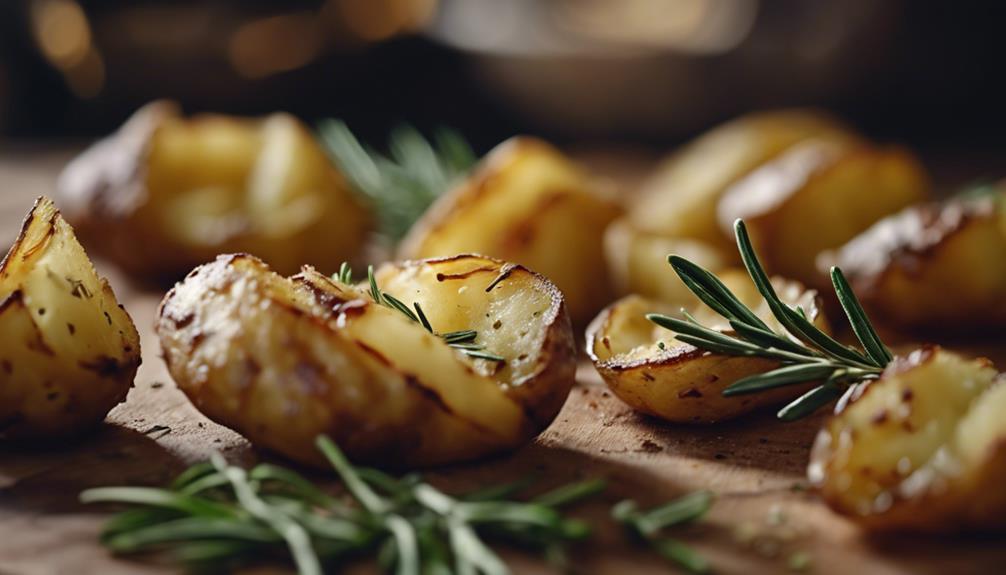
Italian cuisine embraces the use of rosemary to elevate the flavor profile of roasted potatoes, creating a delightful side dish that complements various meals. The aromatic and earthy notes of rosemary perfectly complement the starchy sweetness of the roasted potatoes, making it a classic combination in Italian cooking. Fresh rosemary sprigs are often used to infuse the potatoes with a subtle herbal flavor, enhancing the overall taste experience. The crispy texture of the roasted potatoes paired with the fragrant rosemary creates a comforting dish that is both hearty and flavorful.
To highlight the significance of rosemary in roasted potatoes, let's take a look at the table below:
| Benefits of Rosemary in Roasted Potatoes |
|---|
| Enhances flavor profile |
| Complements starchy sweetness |
| Adds depth and complexity to the dish |
| Creates a comforting and flavorful experience |
Next time you prepare roasted potatoes, don't forget to add a touch of rosemary for that extra burst of flavor and aroma!
Rosemary in Meat Dishes
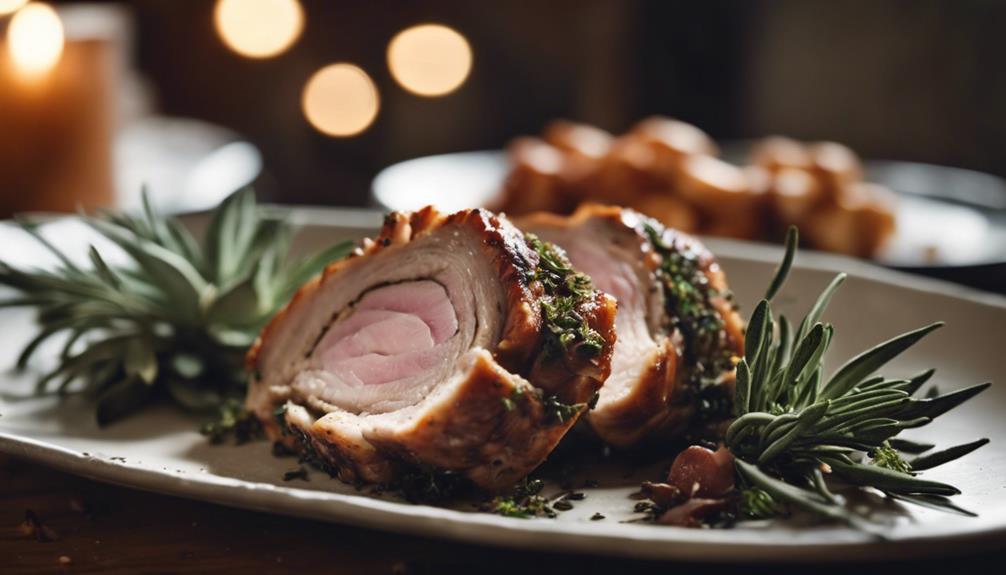
When it comes to incorporating rosemary into meat dishes, you're in for a flavorful treat. Rosemary in roasts infuses a delightful earthiness into your meat.
While grilling with this herb adds a touch of freshness and depth to your favorite cuts.
Don't forget stews – rosemary can take your hearty meat stews to a whole new level of aromatic goodness!
Rosemary in Roasts
Enhance the flavor of your roast chicken with the aromatic touch of rosemary, a favorite herb in Italian meat dishes.
Here's why rosemary is a must-have ingredient for your next roast:
- Flavor Infusion: Rosemary's pine-like flavor infuses the meat during roasting, creating a fragrant and savory taste that elevates the dish.
- Traditional Italian Dish: Roast chicken with rosemary is a classic Italian favorite, where the herb is often used inside the chicken or as a marinade, enhancing the depth of flavors.
- Aromatic Experience: Rosemary-infused roasted meats are a staple in Italian cuisine, offering a delicious and aromatic dining experience for those enjoying the meal.
- Sophistication and Authenticity: Using rosemary in roasts not only adds a unique taste but also brings a touch of sophistication and authenticity to traditional Italian meat dishes.
Next time you prepare a roast chicken, don't forget to add a sprinkle of rosemary for that extra burst of flavor and a touch of Italian culinary heritage!
Rosemary in Grilled Meats
To elevate the flavor of your grilled meats, consider incorporating rosemary for its fragrant and earthy profile. Grilled meats, such as lamb chops, chicken, steak, and pork tenderloin, all benefit from the addition of this versatile herb.
Imagine the aroma of rosemary-infused grilled chicken wafting through the air, tempting your taste buds with its savory notes. Picture sinking your teeth into a succulent Italian-style rosemary steak, where each bite is a burst of flavor that leaves you craving more.
Whether you're grilling up some lamb chops seasoned with rosemary or indulging in a rosemary-marinated pork tenderloin, the herb's presence adds a touch of Mediterranean charm to your meal.
Rosemary in Stews
Incorporate the fragrant herb rosemary into your meat stews to infuse them with a delightful Mediterranean charm and depth of flavor. Here are four key points to keep in mind when using rosemary in chicken stew:
- Italian Rosemary Chicken Stew: This hearty dish combines rosemary-infused chicken with olives and a special sauce reminiscent of Puttanesca, offering a savory and rich flavor profile.
- Chicken Thighs for Flavor: Opt for chicken thighs when making this stew to enhance the taste. The richness of the meat pairs perfectly with the aromatic rosemary.
- Versatile Serving Options: This stew is versatile and can be served with bread, rice, pasta, or greens, catering to different preferences and occasions.
- Bright and Complex Flavor: Rosemary adds brightness and complexity to the stew without weighing it down, making it a delightful choice for Italian-inspired meals.
Rosemary in Vegetarian Dishes
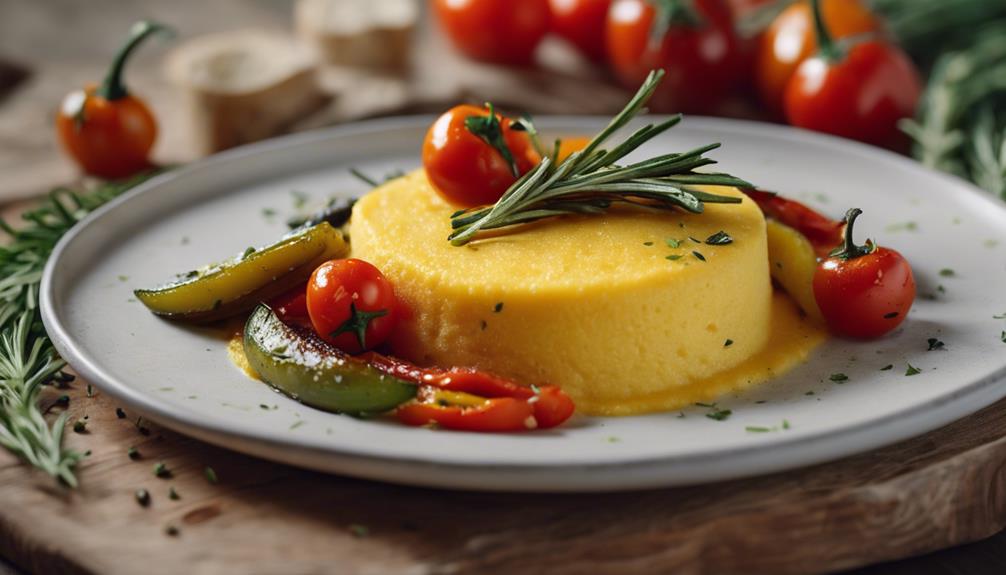
Using rosemary in Italian vegetarian dishes adds a burst of flavor and aroma that elevates the overall dining experience. When it comes to vegetarian cuisine, rosemary can be a game-changer, especially when paired with ingredients like butternut squash, potatoes, and olives. The earthy and fragrant notes of rosemary complement the savory profiles of these dishes, creating a satisfying and aromatic meal for herb enthusiasts.
Check out the table below for some creative ways to incorporate rosemary into your vegetarian Italian recipes:
| Vegetarian Dish | Description | Recipe Link |
|---|---|---|
| Rosemary Roasted Vegetables | A colorful medley of veggies infused with rosemary and olive oil for a flavorful side dish. | [Recipe](#) |
| Butternut Squash Risotto | Creamy risotto with roasted butternut squash and a hint of rosemary for a comforting meal. | [Recipe](#) |
| Rosemary Focaccia Bread | Freshly baked bread topped with fragrant rosemary, sea salt, and olive oil for a delicious appetizer. | [Recipe](#) |
| Tuscan White Bean Soup | Hearty soup with white beans, vegetables, and rosemary simmered to perfection for a cozy dinner. | [Recipe](#) |
| Eggplant Parmesan with Rosemary | Classic Italian dish layered with eggplant, marinara sauce, and rosemary-infused breadcrumbs. | [Recipe](#) |
Try these recipes to experience the delightful combination of rosemary and Italian vegetarian cuisine firsthand!
Versatility of Rosemary in Italian Cuisine
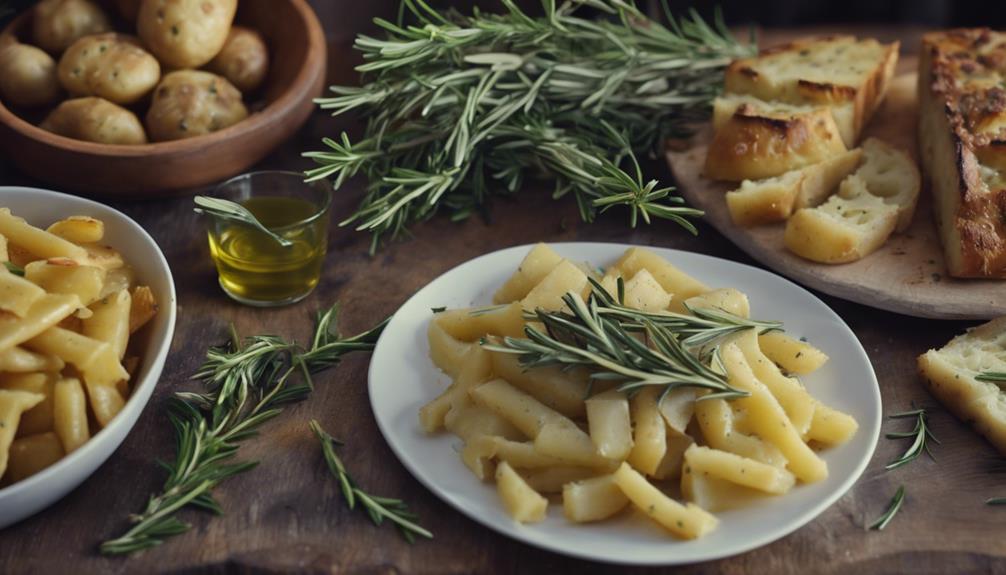
Rosemary's versatility shines through in Italian cuisine, enhancing a wide array of dishes with its aromatic and pine-like flavor. Here's why this herb is so essential in traditional Italian cooking:
- Complementing Meats: Rosemary's robust flavor pairs perfectly with meats like chicken, lamb, and beef, infusing them with a delightful earthiness that's quintessentially Italian.
- Enhancing Bread: From focaccia to rustic loaves, rosemary adds a fragrant touch to traditional Italian bread, creating a sensory experience with every bite.
- Balancing Sweet and Savory: In dishes like Schiacciata con uva Focaccia and Rustic Semolina Lemon Rosemary Cake, rosemary bridges the gap between sweet and savory, elevating the overall taste profile.
- Versatile Seasoning: Whether sprinkled on roasted vegetables, mixed into pasta sauces, or baked into desserts, rosemary's versatility knows no bounds in traditional Italian cuisine, making it a staple herb in the kitchen.
Frequently Asked Questions
What Is Rosemary Used for in Italian Cooking?
In Italian cooking, rosemary is a versatile herb that adds a fragrant and earthy flavor to dishes. It complements savory ingredients like garlic, olive oil, and tomatoes, enhancing meat, bread, soups, and desserts.
What Food Is Rosemary Used In?
You'll find rosemary enhancing various Italian dishes, from roasted meats to pasta and desserts. Its aromatic touch elevates flavors in traditional recipes like pasta with apples and guanciale. Explore the depth of rosemary in Italian cuisine.
What Herbs Are Used in Italian Cuisine?
In Italian cuisine, herbs like basil, oregano, parsley, and thyme are commonly used to enhance flavors. The fresh herbs are essential for depth in dishes. The classic combination of rosemary with garlic, olive oil, and lemon is widely appreciated.
What Is the Most Popular Herb in Italy?
You want to know the most popular herb in Italy? Well, brace yourself for an aromatic journey because it's none other than rosemary! Its intense flavor and versatility elevate countless Italian dishes to culinary perfection.
What Italian Dishes Incorporate the Use of Rosemary?
Rosemary is a popular herb used in various Italian dishes and cuisine. Some classic Italian dishes that incorporate the use of rosemary include rosemary focaccia, roasted rosemary potatoes, and Tuscan rosemary chicken. The fragrant and earthy flavor of rosemary adds a delightful dimension to these traditional Italian dishes.
Conclusion
In the world of Italian cuisine, rosemary is a versatile herb that adds depth and flavor to a variety of dishes. From roasted lamb to pasta sauces, this herb brings a touch of Mediterranean magic to the table.
As the old adage goes, 'when in doubt, add rosemary' – it's a simple way to elevate your cooking and impress your guests with authentic Italian flavors.
So go ahead, sprinkle some rosemary and let your taste buds dance!


